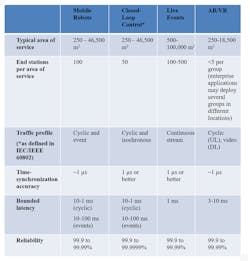The Road to Wireless TSN: Its Capabilities and KPIs
This article is part of TechXchange: Time for Time-Sensitive Networking.
What you’ll learn:
- The benefits time-sensitive networking (TSN) can bring to wireless networks.
- The similarities among use cases that will pave the way for faster innovation and WTSN market growth.
There’s no question that time-sensitive-networking (TSN) capabilities will come to wireless networks. IEEE and 3GPP already have the standards infrastructure to deliver time-sensitive traffic over both Wi-Fi and 5G networks well underway. The market demand also is certainly evident, coming from a diverse set of use cases.
In industrial use cases, wireless TSN (WTSN) will enable more nimble, efficient production, with reconfigurable factory floors, mobile robots, and automated guided vehicles. In live media, WTSN will replace miles of cable that must be painstakingly redeployed, tested, and troubleshot on a nightly basis at every stop of a tour. In extended reality (XR), WTSN will finally un-tether all of the components of immersive XR systems, giving users true freedom of movement while preventing the latency and jitter issues that can lead to nausea and prevent sustained engagement. Each of these applications needs WTSN to reach its fullest potential.
The question is, therefore, not whether or not implement WTSN, but how. Even without the added challenge of a wireless physical layer, TSN is a varied toolbox with lots of optional features. We don’t anticipate that they will all simultaneously arrive as wireless capabilities. Nor do we think WTSN will necessarily roll out the same way across all industries—factories and live performances have very different networking priorities and market demands.
It doesn’t mean, though, that there’s no common ground between them. Identifying the similarities among these applications now, while WTSN is still in its early stages, will pave the way for faster innovation and WTSN market growth. Otherwise, we run the risk of creating cul-de-sacs of protocols and devices that, however useful their particular innovations may be across industries, they can never interoperate or coexist on the same network.
As a member of Avnu Alliance, a community open to all organizations interested in advancing the deployment of TSN-based open standards, I’ve been working alongside fellow members of the Wireless TSN Working Group to map this territory.
Earlier this year, we released a whitepaper, “Wireless TSN: Market Expectations, Capabilities, & Certification” outlining key performance indicators (KPIs) for WTSN applications. One of the significant findings of this paper was that the various applications in which WTSN is likely to mature first, despite their different priorities, need similar capabilities and ultimately have comparable KPIs.
Surveying the Common Ground
Time-synchronization accuracy, bounded latency, and reliability have all emerged as high-priority WTSN capabilities. Security also is a concern across the board: All WTSN applications are expected to adhere to industry best practices including with respect to authentication, integrity, confidentiality, availability, and resiliency to potential interference or attacks. The table presents a snapshot of the paper’s findings.
There’s more similarity than differences here. According to our findings, for most WTSN applications:
- Time-synchronization accuracy requirements are around 1 µs.
- Bounded-latency requirements are 10 ms or less.
- Reliability requirements considerably exceed those of general consumer or workplace network applications.
These KPIs are achievable on either W-Fi or 5G wireless networks. 802.AS clock synchronization is enabled by the current release of the IEEE 802.11 (Wi-Fi) standard and supported by 3GPP Rel 16.
Bounded-latency requirements can be met using the 802.1Qbv (time-aware shaper) standard, which offers extremely predictable data-delivery performance. 802.1Qbv can operate in combination with the latest Wi-Fi scheduling capabilities available in both Wi-Fi 6/6E and 5G systems.
Particularly in safety-critical applications like industrial automation, reliability can be ensured via the IEEE 802.1CB Frame Replication and Elimination for Reliability (FRER) standard, which is transparent to the MAC/PHY network layers. As such, FRER can function on either 5G or Wi-Fi wireless networks, though implementation may differ across system types.
In short, there are many very different applications with fundamentally similar WTSN KPIs. These markets are naturally going to use a widely varying mix of products and infrastructure design best suited to their particular applications.
Because of the similar requirements at play, though, each WTSN market will develop faster and more successfully if it’s able to draw upon the best practices, innovations, and even chipsets and hardware developed by the others. Ultimately, the TSN ecosystem will be best served by a coordinated approach that allows multiple application protocols to share wired and wireless links through interoperable devices.
The Path to Interoperability
An interoperable WTSN ecosystem is possible, and it benefits everyone—but we’ll only get there intentionally. Avnu has been working internally, as well as partnering with other industry consortia, to develop the foundation for both industry-spanning TSN interoperability testing and certification.
Such a system will help vendors understand whether their devices meet the baseline requirements that’s expected by the market. It also will help network designers and integrators feel confident that a system including both wired and wireless TSN components will work.
Because we believe that wired and wireless TSN network segments will and must coexist, Avnu has spent the past year conducting unified testing of both wired and wireless TSN functionality. We’ve held multiple in-person “plugfest” interoperability events to check functionality and prepare for certification. Our test plans assess performance at both the device and system level—certified devices will both deliver the required TSN KPIs and interoperate successfully with other certified devices, regardless of manufacturer.
This is a deliberate and ongoing process. Our WTSN test plan for Wi-Fi has been refined over several interoperability events, and we anticipate that Rel. 1 will be publicly available in Q1 2023. At the same time, 5G test plans are under development within the WTSN working group, with interoperability events expected to commence in Q2 2023 and continue throughout the year. This effort will culminate in a unified WTSN test plan, and several interop testing events in 2023.
If you’d like to get involved in laying the foundation for interoperable wireless TSN, now is the ideal time. Silicon vendors, network infrastructure providers, and device manufacturers are encouraged to join Avnu Alliance and enlist in the effort to ensure that next-generation network capabilities propagate across industries with a strong underlying foundation of interoperability and open standards.
Read more articles in the TechXchange: Time for Time-Sensitive Networking.
About the Author

Dave Cavalcanti
Principal Engineer, Intel and Avnu Alliance Wireless TSN Workgroup Chair
Dave Cavalcanti is a principal engineer in the Edge Computing Group at Intel Corp., where he develops next-generation wireless connectivity and networking technologies and applications in autonomous, time-sensitive systems. He leads a team developing Wireless Time-Sensitive Networking capabilities over next-generation 802.11 and 5G networks. He is Senior Member of the IEEE and serves as the President of the Wireless TSN working group in the Avnu Alliance.

